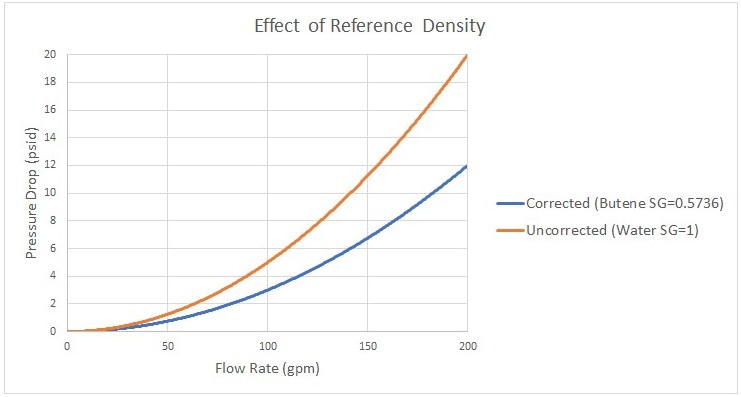Reference Density
A relationship can be drawn for many components between flow energy and flow rate. This can be a decrease (e.g., a loss across a valve) or increase in energy (e.g. energy added by a compressor). The specific parameter used to represent flow energy can vary depending on application. It can be given in terms of pressure change or head change, and there is a critical difference between the two.
Consider a centifugal turbomachine (a pump or radial compressor): Kinetic energy is imparted to the fluid by accelerating it along the radius of the impeller. If the rate of rotation is held constant, a denser fluid will have more energy imparted to it than a lighter weight fluid. This would give rise to higher pressures. In other words, the pressure change depends on the density of the fluid.
Sometimes curves are provided in terms of head. This is convenient because head is a unit of specific energy - or energy per weight. Therefore, it does not vary with fluid density like pressure does. The head added to a fluid by a pump or compressor at a fixed speed, for example, will be the same for fluids of different densities.
However, head relationships are not always available or meaningful. If a pressure vs flow relationship is used, a reference density must be specified. This is the fluid density used during testing and creation of the curve by the component manufacturer. By default, AFT software will use the density of the working fluid in the model defined on the Fluid panel, but this can be changed using the Reference Density setting on certain junctions.

Figure 1: Visual comparison of Pressure Loss Curves for differing densities (head curves would be identical for this component)
Note: Incompressible liquids are used in the example in Figure 1, but the principles apply similarly to compressible flow.
Affected Parameters
There are several parameters that are affected by the density of the fluid:
- Pressure - As discussed above
- Mass Flow - The mass term contains information about the density of the fluid
- Power - More power is demanded by a compressor to meet the head curve for a denser fluid. While head is independent of density and therefore often reported by manufacturers, power is not independent of density. Therefore, a proper specification sheet that includes power must also include the reference fluid density.
Accounting for Reference Density
Compressors and Resistance Curves allow for the specification of a reference density if one of the above parameters is selected. The selection appears below the curve fit area as shown in Figure 2.

Figure 2: Reference Density Selection
Reference Density - density of the fluid that the manufacturer used during testing to generate the pressure loss vs flow data for the component.
System Fluid Density - density of the fluid defined within the AFT model on the Fluid panel.
If the System Fluid Density significantly differs from the Reference Density, then a correction should be made using the Reference Density option.
-
No Correction (default) - This selection assumes that the component’s pressure loss data was developed by the manufacturer using the same fluid that is defined in the model on the Fluid panel.
-
User Specified - This directly specifies the reference density. The user should enter the density of the fluid that the manufacturer used during testing to generate the pressure loss vs flow data. If the Analysis Setup Fluid differs, then the entered curve will be corrected.
Related Topics



